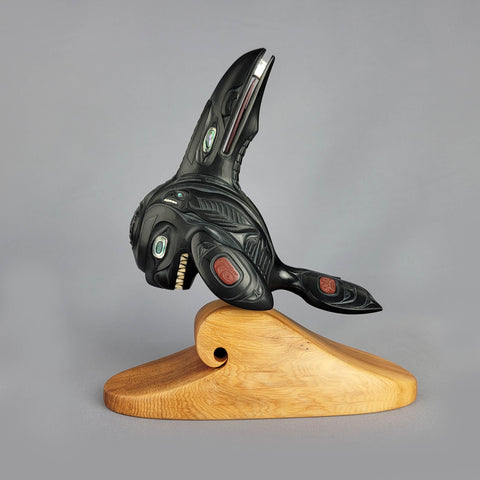Killer Whale Mask by Talon George, Kwakwaka'wakw
The Orca, or Killer Whale, is a significant symbol in Northwest Coast culture and art, with many different meanings and legends.
Predominantly, the Orca is a symbol of family, harmony and community. The Orca will often spend their whole life traveling with the same pod or large family group, working to protect all members of their pod, and raising each calf with care. The Orca is also a symbol for romance as the whale mates for life.
Protection and travel are also reflected in the Killer Whale. Known as the “Lord of the Ocean”, the Killer Whale is said to be the guardian of the ocean, with seals as his slaves and dolphins as his warriors. He protects those who travel away from home, and leads them back when the time comes.
Sanctuary limited edition print by Andy Everson, K'omoks
There are many legends and stories about the Killer Whale.
It is said that when a human drowns at sea the human is taken down by Killer Whales into their deep villages and transformed into a Killer Whale. When a Killer Whale is seen offshore he is believed to be a deceased human or chief trying to communicate with loved ones on land.
One story recounts how the white markings appeared on the Killer Whale. It is said a Killer Whale fell in love with an Osprey. The Killer Whale would jump out of the water and into the air, to be closer to the Osprey, and the Osprey would fly lower to meet the whale. They had a child together and the child was born black like the Whale but with white markings from the Osprey.
Another legend tells of how Killer Whale originated from a single great white Wolf that leapt into the sea and transformed into a Killer Whale. That is why they have the white markings on their sides, travel in packs, and are such skilled hunters.
Raven Fin by Darrell White, Haida
The Haida people tell a story of two Killer Whales, Raven Fin and Noisy Fin. In the legend, a talented carver Go’ttca is left behind on a hunting trip. Stranded, he carves two supernatural Killer Whales out of yew wood that come to life when he throws them into the sea. These two Killer Whales are Raven Fin and Noisy Fin.
While the people of the village believed the carver had perished, Go’ttca instructs the supernatural Whales to provide food for his village. Noisy Fin is killed by a Devil-Fish or Octopus who has reeked havoc on the sea and land, killing many sea creatures and village people. Raven Fin calls upon all the sharp-toothed creatures of the sea to destroy the Octopus that killed his brother.
Wasco sculpture by Jack Pollard, Haida
Another Haida legend is that of the mythological creature The Wasco. A giant sea monster, the Wasco has the dorsal fin and blowhole of a Killer Whale and the head and tail of a Wolf. He has the ability to move both in water and on land, terrorizing villages and hunting Killer Whales to feed his family.
These are just a few of many legends about the Killer Whale. The Orca is a prominent and meaningful symbol in Northwest Coast oral histories and culture. The deep respect and connection felt for this figure is evident in both historical and contemporary Northwest Coast art and design.
Find more depictions of The Orca or Killer Whale here.








